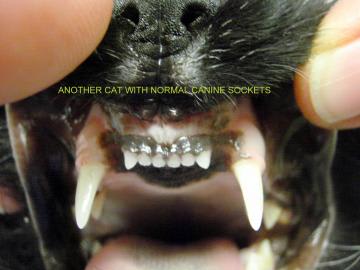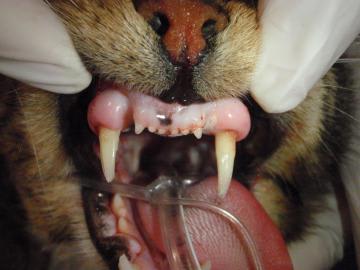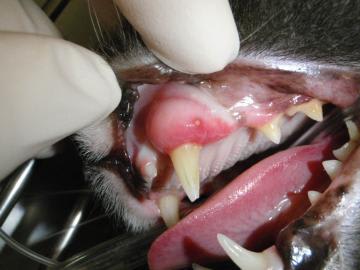We are about to show you something that we commonly see in cats called alveolar osteitis. Despite being common, many veterinarians do not know about it. In just minutes, you will be able to check your own cat to determine whether he or she may be suffering from it.
Normal Fang Teeth
Looking at the two upper prominent “fang” teeth in the picture on the right, note that the surrounding gum tissue is not swollen, red or inflamed. (The normal color of this cat’s gums above the incisor teeth is gray and they are glistening in the light.)


Abnormal Fang Teeth
In the picture to the left, the gum tissue is red, inflamed, and swollen from bacterial periodontal infection. The dramatic swelling above the fang teeth is due to swelling of bone that makes up the tooth socket underneath the gum.
Bacteria are able to infect the bone by ascending in an abnormal gap between the tooth and the gum, which is present because of the periodontal disease.
Note that the tooth on the right appears longer than the one on the left. This process is called extrusion and is due to the tooth being pushed out of its socket in response to infection and periodontal disease. In this picture and the ones that follow, the cats are sedated and have endotracheal breathing tubes.
This picture demonstrates a tooth socket that is so infected that a pustule full of white cells and bacteria is forming on the surface.
In cats with alveolar osteitis, the infection may be ongoing for months to years, and while these cats may not appear to be in pain, they are! The onset of oral cavity disease can be so gradual that cats may learn to “adapt” to their pain and hide their pain due to their survival instinct. They also have a limited number of ways to tell us that they are in pain.
Treatment for this condition involves surgical extraction of the tooth and removal of infected bone. The pet is then sent home with a long acting antibiotic injection, pain medication and absorbable sutures. Owners often remark weeks later, “He’s like a new cat…I had no idea this was going on."

Dentistry for dogs and cats is very rewarding! Pets typically go home, start eating that night and make a quick recovery, even after gum surgery. Dentistry relieves pain and discomfort and gives our patients a new lease on life! Take a look at your cat’s teeth and gums today, or call us and we will be glad to do it for you. Your cat will thank you!
